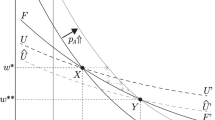Abstract
This paper studies the effects of pension reform in a two-country model with country-specific goods. It shows that in the case of dynamic efficiency, a switch from a pay-as-you-go to a more-funded pension scheme leads to an inflow of labour to the reforming country. Reallocation of capital depends on the degree of substitutability between goods produced in the countries. If the goods produced in the countries are substitutes (complements), capital stock grows (declines) in the reformed country relative to the neighbouring country. Social security reform makes goods produced in the reformed country cheaper; this has an additional negative effect on the old generation in the reformed country, but compensates the old generation in the neighbouring country with cheaper imports due to a reduction in the tax base arising from emigration.



Similar content being viewed by others
Notes
The local Norway news in English, 26 July 2012.
The derivation of Eq. (17) is given in the “Appendix”.
References
Adema, Y., Meijdam, A. C., & Verbon, H. A. A. (2009). The international spillover effects of pension reform. International Tax and Public Finance, 16, 670–696.
Amdur, D. (2010). International cross-holdings of bonds in a two-good DSGE model. Economics Letters, 108, 163–166.
Armington, P. (1969). A theory of demand for products distinguished by place of production. International Monetary Fund Staff Papers, 16(1), 159–178.
Attanasio, O., Kitao, S., & Violante, G. L. (2007). Global demographic trends and social security reform. Journal of Monetary Economics, 54(1), 144–198.
Blonigen, B. A., & Wilson, W. W. (1999). Explaining Armington: What determines substitutability between home and foreign goods? Canadian Journal of Economics, 32(1), 1–21.
Börsch-Supan, A., Ludwig, A., & Winter, J. (2006). Ageing, pension reform, and capital flows: A multicountry simulation model. Economica, 73(292), 625–658.
Breyer, F. (1989). On the intergenerational Pareto efficiency of pay-as-you-go financed pension systems. Journal of Institutional and Theoretical Economics, 145, 643–658.
Buškutė, I., & Medaiskis, T. (2011). Balancing the security and affordability of funded pension schemes: Statements an.d comments. Paper presented at the Peer Review of the Netherlands’ Pension System. Hague, April 12–13
Cooper, R., & Kempf, H. (2004). Overturning Mundell: Fiscal policy in a monetary union. Review of Economic Studies, 72(2), 371–396.
Fedotenkov, I., & Meijdam, L. (2013a). Crisis and pension system design in the EU: Intergenerational redistribution and international spillover effects via factor mobility and trade. De Economist, 161(2), 175–197.
Fedotenkov, I., & Meijdam, L. (2013b). Pension reform with migration and mobile capital: Is a Pareto improvement possible? International Economics and Economic Policy. doi:10.1007/s10368-013-0259-2.
Fedotenkov, I., van Groezen, B., & Meijdam, L. (2014). Demographic change, international trade and capital flows. Open Economies Review. doi:10.1007/s11079-014-9311-2.
Fehr, H., Jokisch, S., & Kotlikoff, S. (2003). The developed world’s demographic transition: The roles of capital flows, immigration and policy. NBER working paper series. Working paper no. 10096.
Geide-Stevenson, D. (1998). Social security policy and international labor and capital mobility. Review of International Economics, 6(3), 407–416.
Geide-Stevenson, D., & Ho, M. S. (2004). International labor migration and social security: Analysis of the transition path. Journal of Population Economics, 17(3), 535–551.
Kenc, T., & Sayan, S. (2001). Demographic shock transmission from large to small countries an overlapping generations CGE analysis. Journal of Policy Modeling, 23(6), 677–702.
Kugler, M., & Rapoport, H. (2007). International labor and capital flows: Complements or substitutes? Economics Letters, 94, 155–162.
Mendoza, E. G., & Tesar, L. L. (2005). Why hasn’t tax competition triggered a race to the bottom? Some quantitative lessons from the EU. Journal of Monetary Economics, 52, 163–204.
Palacios, R., & Palarès-Miralles, M. (2000). International patters of pension provisions. Social protection discussion paper series no. 0009, The World Bank, Washington, DC
Raudla, R., & Staehr, K. (2003). Pension reforms and taxation in Estonia. Baltic Journal of Economics, 4(1), 64–92.
Razin, A., & Sadka, E. (1992). International migration and international trade. NBER working paper series. Working paper no. 4230.
Razin, A., & Sadka, E. (2010). Fiscal and migration competition. CESIFO working paper no. 3075.
Shiells, C. R., Stern, R. M., & Deardorff, A. V. (1986). Estimates of the elasticities of substitution between imports and home goods for the United States. Weltwirtschaftliches Archiv, 122, 497–519.
van Ewijk, C., & Volkerink, M. (2012). Will ageing lead to a higher real exchange rate for the Netherlands? De Economist, 160, 59–80.
Vasile, V., & Zaman, G. (2005). Romania’s pension system; between present restrictions and future exigencies. PIE Discussion paper series.
Verbon, H. A. (1989). Conversion policies for public pensions plans in a small open economy. In Gustafsson, B., & Klevmarken, N. (eds.) The political economy of social security. Elsevier Science, Amsterdam.
Author information
Authors and Affiliations
Corresponding author
Appendix
Appendix
1.1 Derivation of Equation (5)
As mentioned in the text, if an agent chooses to exchange one unit of goods produced in the Home country for composite goods, her optimal inputs to composite goods are \(X_{t}= 1/\big (1+p_{t}^{1-\theta }\big ((1-\gamma )/\gamma \big )^\theta \big )\) and \(X_{t}^{'}=1/\big (p_{t}+\big (p_{t}\gamma /(1-\gamma )\big )^\theta \big )\). Inserting these values into Eq. (3) we find, that she can buy
composite goods. Note that
then
1.2 Derivation of Equation (17)
Inserting \(C_{t}^{y}=\Psi _{t}^{y}/\big (1+p_{t}^{1-\theta }((1-\gamma )/\gamma )^\theta \big )\), \(C_{t}^{'y}= \Psi _{t}^{y}\big (p_{t}+(p_{t} \gamma /(1-\gamma ))^\theta \big )\) and so forth to Eqs. (15–16), we get
Dividing one equation by another we get Eq. (17).
Rights and permissions
About this article
Cite this article
Fedotenkov, I. Pension Reform, Factor Mobility and Trade with Country-Specific Goods. De Economist 162, 247–262 (2014). https://doi.org/10.1007/s10645-014-9233-9
Published:
Issue Date:
DOI: https://doi.org/10.1007/s10645-014-9233-9
Keywords
- Pension reform
- Mobile production factors
- International trade
- Elasticity of substitution
- Race to the bottom
- Spillovers




